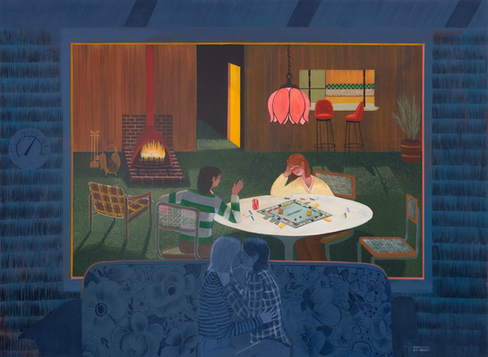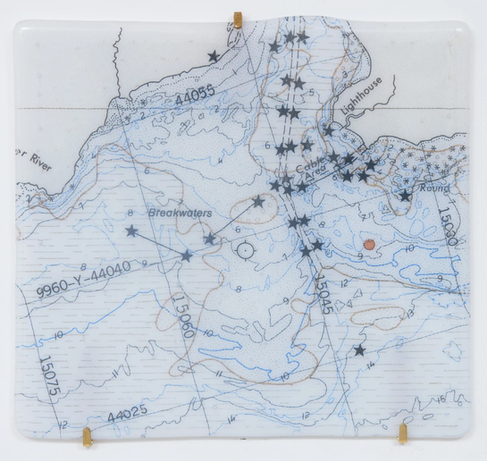EYES OPEN, I BREATHE AGAIN AT ALICE AMATI
- Tamsyn Chandler
- Aug 1
- 4 min read
Where is memory? Is it in the mind? Does it live in golden-hued photographs, or sunsets in August? At Eyes Open, I breathe again at Alice Amati, I was haunted by these questions, examining the concept of a summer relationship remembered, captured in both the visual and the written word. Eyes Open I Breathe again is an exhibition running Fitzrovia that touches upon something rare: earnestness. The exhibition spans geographies, spiritualities and emotional distance, blending narrative curation with a range of mediums.

Installation photography courtesy of gallery
Eyes Open, I breathe again comprises a group of international artists curated by Samuele Visentin, who also wrote the accompanying text that informs the exhibition itself. There is a sense of Summer, of lost and found, and of the tactile. An attempt to make memory solid, to call it back. Materials include glass, found lace, biscuit de porcelain, oil on linen, presented in a fresh and spacious , painted in clean blue and white. The opening night itself reminds me of the recent literary salon nights that have become so popular with a younger crowd: groups spill out onto the street drinking beer and San Pellegrino. Clearly, the desire and hunger to see and engage with art is persisting.

Accompanying the show is the internal narrative of fictional character K, “Conceived as a visualisation of a summer love story," it reads, "each work in the exhibition represents a phase in this journey - from the arrival in a yet unknown place, to the first encounter, infatuation, intimacy, and eventually, departure.” The journey in the space transitions between moods. with the upstairs being more melancholic, and downstairs, a dreamy space of imagination and summer fun through a bittersweet queer lens.
The show touches on the idea of disembodiment, of living in a world that is both beautiful and a struggle to navigate when threatened with latent violence and opposition. With different scenes from light dappled shore to bedroom with the blinds drawn from the midday sun, the show presents identity as construct floating over an alternate space and time, enableing the queer body to lift itself and travel over to a safer space.
There is loneliness and Italian summers from many years ago, but not just melancholy per se: there is an acceptance of things as they come and go and a sense of grounded and self-aware disassociation: “Why is it even difficult to remember?" K asks himself. "...the memories feel broken and difficult to access.”

Installation photography courtesy of gallery
Curator Samuele Visentin explains that the top floor acts almost as a quieter prelude, with the basement crossing over fully into the dream. The maps of an unknown archipelagic location dot the upstairs and downstairs of the exhibition, almost like punctuation for the narrative of the visual medium. These are Ju Young Kim’s Not for Navigation, photographic prints on glass: teal maps with starlike coordinates. Kim’s work is interested in liminal states and symbolically encoded works, and Eyes Open, I breathe again is nothing if not liminal. In her conceptual explorations, she examines the relativity of space and time from the perspective of a transcontinental traveler.
From left to right: Marcelle Reinecke, Lake House, 2025, Ju Young Kim, Not for Navigation #8
I am struck, too, by the paintings of Phyllis Yao, namely Portrait as Greek Statue (2024) and Lonely (2024) and their juxtaposed exploration of how self-creation and myth-making often feeling a solitary endeavour, especially when experienced through rites of passage and development. In Lonely (2024), an almost esoteric eye appears on a shaft of light through the dark blue gloam of the room, taking us back to strange adolescent August nights where everything was uncertain, possible and unsettled. Yao’s wide-ranging imagery explores feelings of paranoia, love, hope, loneliness, and the anxiety of living in an ever-shifting world. Elsewhere, there are lake houses, boat houses, and beaches in alternating hues appearing from artists such as Marcelle Reinecke (whose work blends historical homage and personal narrative, often depicting everyday women through a queer lens) and David Hovarth’s expertly rendered late Summer hues, the colour palettes blending reality like a shimmering mirage.

In the basement there are hues of Romanesque gold against clay blue, crowns of lace, faces looking on, looking away, lying down, looking up. At the back facing wall in the basement is a painting by Inès Michelotto that embodies the liminality and transformative qualities of adolescence. I love this side of you (2025) is at once an intimate painting reminiscent of Joanne Leonard’s photographic work, bare almost pewter tinted flank lit by life perhaps happening outside. The title is a reminder of tenderness being filtered through the lens of eroticism - with the socks left on.
Visentin explains that the process was layered: the concept coming and text came first, with the artists being chosen second. The text was edited and evoled while more artists joining the programme, adding to the memetic layering of the theme.
When leaving the gallery at the end of July, one is left with an impression of honesty and the lingering sense of summer’s inevitable end on the horizon. There is nevertheless hope in the sentiments and impressions of life captured and held with such purity: perhaps memory does live outside the mind after all, rendered visible, and held with gentle compassion.
Tamsyn Chandler is a writer and artist based between London and the West Country.







